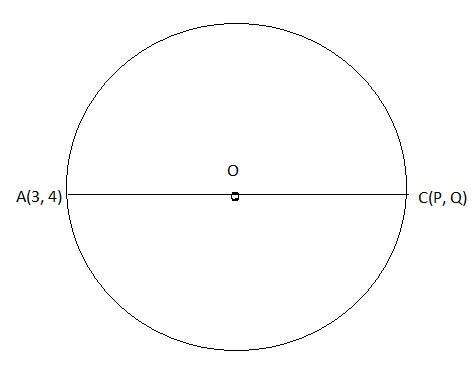
If one end of a diameter of the circle \[\begin{array}{*{20}{c}}
{{x^2} + {y^2} - 4x - 6y + 11}& = &0
\end{array}\]is (3, 4), then the coordinates of the opposite ends are,
A) (1, 2)
B) (2, 1)
C) (-1, 2)
D) None of these
Answer
217.8k+ views
Hint: Determine the center of the circle with the help of the given equation and then we will apply the formula of the midpoint of the line to evaluate the coordinates of the other end of the circle
Complete step by step solution: First of all, we will draw a figure according to the given conditions,

Figure 1
In this problem, we have to find the coordinates of the other end of the circle. Let us assume that the coordinates of the other end of the circle are C (P, Q). As shown in the figure, the diameter of the circle is line AC. Therefore, the midpoint of line AC is Point O (Center of the circle).
Now from the given equation, we will evaluate the center of the circle. Therefore,
\[\begin{array}{*{20}{c}}
{ \Rightarrow {x^2} + {y^2} - 4x - 6y + 11}& = &0
\end{array}\]
In the above equation, add and subtract 2. So, we will get
\[\begin{array}{*{20}{c}}
{ \Rightarrow {x^2} + {y^2} - 4x - 6y + 9 + 2 - 2}& = &0
\end{array}\]
\[\begin{array}{*{20}{c}}
{ \Rightarrow {x^2} + {y^2} - 4x - 6y + 13}& = &2
\end{array}\]
\[\begin{array}{*{20}{c}}
{ \Rightarrow \left( {{x^2} - 4x + 4} \right) + \left( {{y^2} - 6y + 9} \right)}& = &2
\end{array}\]
\[\begin{array}{*{20}{c}}
{ \Rightarrow {{\left( {x - 2} \right)}^2} + {{\left( {y - 3} \right)}^2}}& = &2
\end{array}\]
Now compare the above equation with the general equation of the circle.
\[\begin{array}{*{20}{c}}
{ \Rightarrow {{\left( {x - a} \right)}^2} + {{\left( {y - b} \right)}^2}}& = &{{r^2}}
\end{array}\]
We will get,
\[\begin{array}{*{20}{c}}
{ \Rightarrow a}& = &2
\end{array}\] and \[\begin{array}{*{20}{c}}
b& = &3
\end{array}\]
Therefore, the center of the circle will be O (2, 2).
As we know, the center of the circle is the midpoint of the Line AC.
We also know the formula to determine the midpoint of the line.
\[ \Rightarrow \begin{array}{*{20}{c}}
a& = &{\dfrac{{{x_1} + P}}{2}}
\end{array}\]And \[\begin{array}{*{20}{c}}
b& = &{\dfrac{{{y_1} + Q}}{2}}
\end{array}\]
Therefore, the line AC
\[ \Rightarrow \begin{array}{*{20}{c}}
2& = &{\dfrac{{3 + P}}{2}}
\end{array}\]and \[\begin{array}{*{20}{c}}
3& = &{\dfrac{{4 + Q}}{2}}
\end{array}\]
\[ \Rightarrow \begin{array}{*{20}{c}}
P& = &1
\end{array}\]and \[\begin{array}{*{20}{c}}
Q& = &2
\end{array}\]
Therefore, the coordinates of the other end of the circle is (1, 2).
So, Option ‘A’ is correct
Note: It is important to note that the midpoint of the diameter of the circle always lies at the center of the circle.
Complete step by step solution: First of all, we will draw a figure according to the given conditions,

Figure 1
In this problem, we have to find the coordinates of the other end of the circle. Let us assume that the coordinates of the other end of the circle are C (P, Q). As shown in the figure, the diameter of the circle is line AC. Therefore, the midpoint of line AC is Point O (Center of the circle).
Now from the given equation, we will evaluate the center of the circle. Therefore,
\[\begin{array}{*{20}{c}}
{ \Rightarrow {x^2} + {y^2} - 4x - 6y + 11}& = &0
\end{array}\]
In the above equation, add and subtract 2. So, we will get
\[\begin{array}{*{20}{c}}
{ \Rightarrow {x^2} + {y^2} - 4x - 6y + 9 + 2 - 2}& = &0
\end{array}\]
\[\begin{array}{*{20}{c}}
{ \Rightarrow {x^2} + {y^2} - 4x - 6y + 13}& = &2
\end{array}\]
\[\begin{array}{*{20}{c}}
{ \Rightarrow \left( {{x^2} - 4x + 4} \right) + \left( {{y^2} - 6y + 9} \right)}& = &2
\end{array}\]
\[\begin{array}{*{20}{c}}
{ \Rightarrow {{\left( {x - 2} \right)}^2} + {{\left( {y - 3} \right)}^2}}& = &2
\end{array}\]
Now compare the above equation with the general equation of the circle.
\[\begin{array}{*{20}{c}}
{ \Rightarrow {{\left( {x - a} \right)}^2} + {{\left( {y - b} \right)}^2}}& = &{{r^2}}
\end{array}\]
We will get,
\[\begin{array}{*{20}{c}}
{ \Rightarrow a}& = &2
\end{array}\] and \[\begin{array}{*{20}{c}}
b& = &3
\end{array}\]
Therefore, the center of the circle will be O (2, 2).
As we know, the center of the circle is the midpoint of the Line AC.
We also know the formula to determine the midpoint of the line.
\[ \Rightarrow \begin{array}{*{20}{c}}
a& = &{\dfrac{{{x_1} + P}}{2}}
\end{array}\]And \[\begin{array}{*{20}{c}}
b& = &{\dfrac{{{y_1} + Q}}{2}}
\end{array}\]
Therefore, the line AC
\[ \Rightarrow \begin{array}{*{20}{c}}
2& = &{\dfrac{{3 + P}}{2}}
\end{array}\]and \[\begin{array}{*{20}{c}}
3& = &{\dfrac{{4 + Q}}{2}}
\end{array}\]
\[ \Rightarrow \begin{array}{*{20}{c}}
P& = &1
\end{array}\]and \[\begin{array}{*{20}{c}}
Q& = &2
\end{array}\]
Therefore, the coordinates of the other end of the circle is (1, 2).
So, Option ‘A’ is correct
Note: It is important to note that the midpoint of the diameter of the circle always lies at the center of the circle.
Recently Updated Pages
Arithmetic, Geometric & Harmonic Progressions Explained

Cartesian Form of Vector Explained: Formula, Examples & Uses

Apparent Frequency Explained: Formula, Uses & Examples

Calorimetry: Definition, Principles & Calculations

Centrifugal Force Explained: Definition, Formula & Examples

Charge in a Magnetic Field: Definition, Formula & Examples

Trending doubts
Understanding Collisions: Types and Examples for Students

Ideal and Non-Ideal Solutions Explained for Class 12 Chemistry

Degree of Dissociation: Meaning, Formula, Calculation & Uses

Understanding Elastic Collisions in Two Dimensions

Understanding Newton’s Laws of Motion

JEE Main 2026 Syllabus Updated for Physics, Chemistry and Mathematics

Other Pages
NCERT Solutions For Class 11 Maths Chapter 11 Introduction To Three Dimensional Geometry - 2025-26

Inertial and Non-Inertial Frame of Reference Explained

Clemmensen and Wolff Kishner Reductions Explained for JEE & NEET

JEE Main 2023 January 29th Shift 2 Physics Question Paper with Answer Keys and Solutions

Devuthani Ekadashi 2025: Correct Date, Shubh Muhurat, Parana Time & Puja Vidhi

Quadratic Equation Questions with Solutions & PDF Practice Sets




